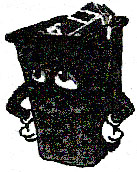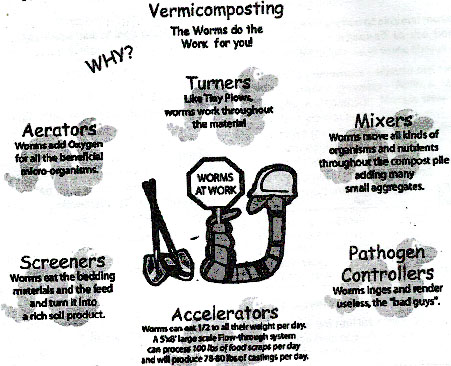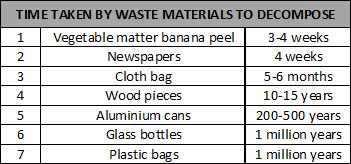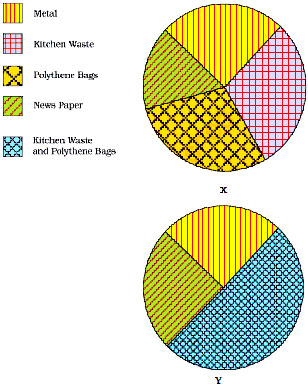
GARBAGE DISPOSAL
A large, low-lying area used to dispose garbage is known as a dump. A garbage dump is also used as landfill. Garbage collectors
collect waste and then dispose it at garbage disposals. Garbage dumps have files, cockroaches and mosquitoes, and later turn into breading
grounds for micro-organisms that may cause diseases. That is why these garbage dumps are usually located on the outskirts of a city.
(a) Components of garbage - Garbage has useful and non-useful components :
Useful garbage components are those that can be decayed easily. The process of decaying is known as composting.
Useful garbage components are fruit and vegetable waste, plant and animal waste, tea leaves, coffee grounds and paper.
These useful components of garbage are converted into manure in the soil.
Non-useful garbage components include polythene bags, plastics, glass and aluminum foils.
These take longer to decay. Decaying of these non-useful components is known as decomposition.
When non-useful components decay, they release harmful gases that damage the environment.
To avoid the adverse impact, these garbage items are sent for recycling. For example, when leaves
bum, they release harmful gases and causes air pollution. Moreover, they lead to asthma and lung diseases.
That is why leaves should be buried so as to convert them into manure.
.
VERMICOMPOSTING:
The process of preparing compost with the help of red worms is called vermicomposting. The red worm is a type of earthworm that lives in the soil rich in organic matter. which is a combination of nitrogen-rich and carbon-rich material with plenty of moisture and microbes.
· Method of Vermicompositing.
· A vermicomposting pit is made with a wooden box or big cement rings.
· A mesh is spread at the bottom of the pit.
· Vegetable waste, fruit waste paper which is not shiny or coated with plastic, is spread over the mesh
· Water is sprinkled to create moisture so that the redworms can live.
· A vermicomposting pit takes nearly two to four weeks to completely convert waste into manure.
· Waste material that is rich in oils, salt, meat and vinegar stops the growth of red worms.
· These red worms have a special structure called gizzards with which they grind food material.
A red worm eats food equal to its weight every day. Red worms do not survive in too hot or too
cold conditions.
RECYCLING OF PAPER AND PLASTICS
It is important to reuse things than discarding them as waste. Industries use recycled or waste paper to regenerate paper.
Paper that is suitable for recycling is called “scrap paper”. You can recycle old newspapers, magazines, notebooks and used
envelopes, but not waxed paper, oil-soaked paper, paper contaminated with food, carbon paper, thermal fax paper, plastic
laminated paper, stickers, and sanitary products or tissues.
(a) Steps involved in Recycling paper
· Tear paper into small pieces.
· Soak these pieces in water for a day.
· Make a thick paste and spread it on a net or sieve.
· Let water drain off completely.
· Use an old cloth or newspaper to remove the extra water from the paste and dry it.
· Use this paste to get beautiful patterns.
(b) Disadvantages of using of polythene bags
· We use many plastic items such as tooth brush, combs, containers, bottles, shoes, toys, wires,
frames and bags every day but using plastic is very harmful in terms of health and as well as the
environment.
· Plastics are not suitable for storing cooked food because they emit harmful chemicals when
they are exposed to high temperatures.
· Using plastics causes health problems such as heart disease, diabetes and reproductive
dysfunction.
· Harmful gases are emitted from burning plastics, which cause cancer and they kill living beings.
· That is why plastics should be disposed in the right way.
· Plastics thrown casually get into drains and sewages, often blocking the way and
causingwater-logging.
· So polythene bags should not be used for garbage disposal.
MEASURES TAKEN TO PREVENT THE DANGEROUS EFFECTS OF PLASTICS
Reduce, reuse and recycle plastics.”
Carry jute or cloth bags for shopping”
Do not store food items in plastic bags.”
Do not burn plastic items.
Recycle plastics so that new plastic items can be made.”
Waste that does not decompose should be put in blue dustbins, while waste the decomposes easily should be put in green dustbins.”
OBJECTIVE TYPE
1. Vermicomposting involves
(A) leech (B) cockroach (C) earthworm (D) roundworm
2. Reusing materials after they have been changed into a new form is ______
(A) Recycling (B) Reducing (C) Reusing (D) None of these
3. An area where garbage is deposited. Often lined with plastic or or clay to keep harmful chemicals from leaking.
(A) Acid Rain (B) Landfill (C) Pollutants (D) Recycling
4. The most useful type of waste would be
(A) biodegradable waste (B) non-biodegradable waste
(C) metallic waste (D) industrial waste
5. What ways can you help save our earth?
(A) Re-use your plastic bottles and bags
(B) Plant a tree
(C) Recycle
(D) All of the Above !
6. Most of the trash your family throws away each day ends up getting.....
(A) Recycle (B) Burned (C) Landfill (D) Eaten
7. Which items are recyclable ?
(A) Plastic milk jugs (B) Cereal boxes
(C) Aluminum soda cans (D) All of the above
8. Decomposers include
(A) bacteria (B) fungi (C) both (A) & (B) (D) animals
9. Which of the following wastes cannot be decomposed by bacteria to from compost?
(A) Kitchen wastes (B) Plastic and polythene bags
(C) dead plants (D) bodies of insects living in the soil
10. Which one the following is not biodegradable ?
(A) Vegetables (B) fruits (C) earthworm (D) aluminium foil
SUBJECTIVE TYPE
1. How do earthworms increase fertility of soil ?
2. Rag pickers always suffer from diseases why ?
3. Why does composting of leaves better than burning them ?
4. Why should plastic food containers be avoided?
5. Why we should not throw away any things that can be recycled ?
6. Why recycled plastic are not recommended for storing food in ?
7. What is waste management and why it is so important ?
8. Which garden worm generally used for Vermi composting.
9. Why worm box aerated in the process of vermi composting ?
ANSWER KEY
1.C 2.A 3.B 4.A 5.D 6.A 7.D 8.C 9.B 10.D
MULTIPLE CHOICE QUESTIONS
1. The method of preparing compost with the help of earthworms is called
(a) composting (b) vermicomposting
(c) manuring (d) decomposing
2. If you dump kitchen waste in a pit, it may, after sometime
(a) convert into compost. (b) convert into vermicompost.
(c) remain as such. (d) remain forever in its dried form.
3. Which of the following activities does not reflect responsible behaviour with regard to waste disposal?
(a) Goods carried in paper bags or cloth bags.
(b) Waste collected in polythene bags for disposal.
(c) Waste separated into those that degrade and those that do not.
(d) Making handicrafts with used up notebooks.
4. Paheli gave the following ill effects of the practice of burning dried leaves and other plant parts
(i) Burning degrades the soil.
(ii) Burning produces harmful gases/fumes.
(iii) Precious raw materials to obtain manure at low cost is lost.
(iv) Lot of heat is generated unnecessarily.
The correct reasons of why we should not burn leaves are
(a) i, ii and iv only (b) i, ii, iii, and iv
(c) ii and iii only (d) ii, iii, and iv only
5. A garbage collector separate items mentioned below in the garbage into red, green and blue containers for their transfer to landfill, composting pit, and recycling unit respectively.
Items:
(i) Plastic bags
(ii) Newspaper and journals
(iii) Screw and nuts
(iv) Vegetable peels
(v) Metal chips
(vi) Egg shells
Which item were transferred to which bin?
RED GREEN BLUE
(a) (i) and (iv) (ii) and (iii) (v) and (vi)
(b) (i) and (iii) (ii) and (v) (iv) and (vi)
(c) (i), (iii) and (v) (iv) and (vi) (ii) only
(d) (i) and (v) (ii) and (iv) (iii) only
6. The steps required for conversion of kitchen garbage into manure are given below in a jumbled form.
(i) Put garbage in a pit
(ii) Cover the bottom of the pit with sand
(iii) Cover the pit loosely with a gunny bag or grass
(iv) Add worms
Which of the following shows the correct sequence of the above steps?
(a) (ii); (i); (iii); (iv) (b) (i); (ii); (iii); (iv)
(c) (ii); (iv); (i); (iii) (d) (iv); (i); (ii); (iii)
VERY SHORT ANSWER QUESTIONS
7. Read the items mentioned in Columns I and II and fill in the related process in the Column III
Columns I Columns II Columns III
(a) Organic Earthworms (i) ...............
(b) Garbage Dig pit and fill with (ii)...............
Grabage
(c) Old newspaper Paper bags (iii) ...............
8. Correct the definitions of certain terms given below by changing only one word.
(i) Compost: Substances converted into manure for use in industries.
(ii) Landfill: Garbage buried under water in an area.
(iii) Recycling: Reuse of unused material in the same or another form.
9. Provide the suitable term that expresses the meaning of each of the following statements.
(a) Greeting cards made from newspaper.
(b) Contents of the waste bins.
(c) Worms converting certain kinds of waste into manure.
(d) An area where a lot of garbage is collected, spread out and covered with soil.
SHORT ANSWER QUESTIONS
10. To what use can you put the following kinds of garbage and how?
(i) rotting smelly garbage
(ii) dry leaves collected in a garbage
(iii) old newspapers
11. Paheli was writing a letter to her friend. She crumpled and threw the first draft of her letter on the floor as it had become untidy. Similarly she crumpled and threw 6 more papers on the ground. In the end, she picked them up and put them in a polythene bag and threw it on the road outside her house. Do you think Paheli’s action were responsible? What would you have done if you were in her place?
12. Read the poem written below and then answer the questions from the information gathered from the book or elsewhere.
Blur and Green
Two bins, you mean?
Yes, they are there
to throw your wate.
But not in a hurry
Nor in a haste.
Select from waste, sleve if seems muddy
Separate all items and when they are ready
Place in a blue bin, or one that is green
For a voyage to the landfill, or for composting.
Blue and Greenins, you mean?
(i) Name the two kinds of waste that need to be separated from each other in two different waste bins.
(ii) Name two items of waste each that need to be sent to a
(a) landfill, (b) for composting.
13. Beera, a farmer would clear his field everyday, and burn dry leaves fallen on the ground. After sometime he found that those living in huts near his field were suffering from cough and breathing problems. (i) Can you explain why? (ii) Also suggest an environment friendly way to dispose the dry leaves.
LONG ANSWER QUESTIONS
14. Put a tick (“) against the garbage items given in Table 4.1 which could be converted into manure. Put a cross (×) against the others.
Garbage Items Make manure or Not
(i) Egg shells
(ii) Straw
(iii) Dry flowers
(iv) Pebbles
(v) Broken pieces of glass
(vi) Nails and screws
(vii) Plastic bangles
(viii) Left over food
(ix) Steel broken vessel
(x) Dead animals
15. The pie charts A and B shown in Fig. 4.1 are based on waste segregation method adopted by two families X and Y respectively.
Fig. 4.1
Which of the two families X or Y do you think is more environmentally conscious and why?
16. Given below are steps in vermicomposting and each step has been given an alphabet. Rearrange the steps in the correct sequence and write the alphabets on the chart provided. One step is done for you.
F Dig a pit in a suitable place in your garden.
C Spread sand on the floor of the pit.
E Add vegetable peels and fruits waste in the pit.
A Sprinkle water to keep it moist.
D Place red worms in the pit.
B Cover with a gunny bag or grass.
Step 1 - F
2 -
3 -
4 -
5 -
6 -
17. Write 3 sentences on what comes to your mind when you chance to see the following.
(a) A rag picker.
(b) A cow eating a polythene bag.
(c) Foul odour emanating from garbage at the entrance of your house.
18. Beautiful hand crafted articles like boxes and toys are made of paper pulp in our country. Can you explain how paper pulp which is made from paper can be used to make hard boxes and other articles?
19. Recently, a ban on plastic bags has been imposed in many places? Is the ban justified? Give reasons in three sentences.
20. Why should we not burn plastic items?
21. What happens when
(a) Cooking medium is made to flow down a drain.
(b) Insecticides, motor oil, paints are poured down the drain.
(c) Tea leaves, cotton swabs and old soft toys are thrown into the drain.
22. Answer the following questions in one or two words or sentences:
(a) Why should we prefer to use paper bags rather than polythene bags?
(b) Who, out of the following should properly dispose of the garbage – father, mother, elder brother, younger sister?
(c) Which one out of beetles, roundworm and earthworm are used for vermicomposting and why?


